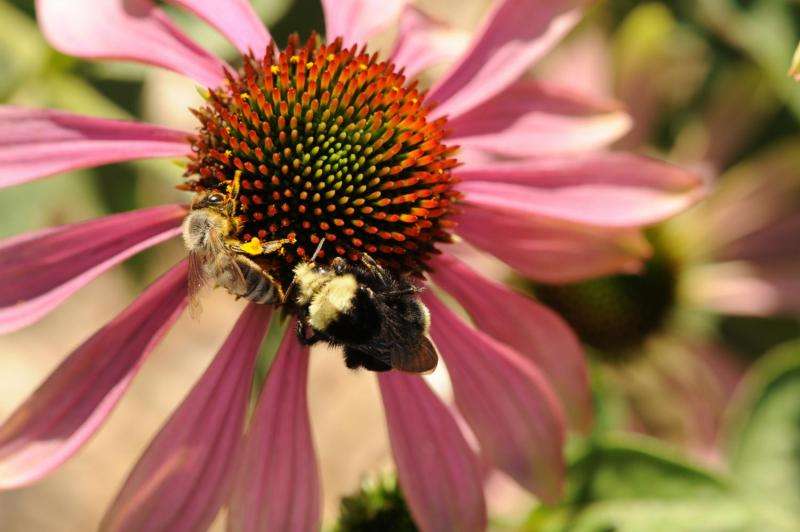Managed bees spread and intensify diseases in wild bees

For various reasons, wild pollinators are in decline across many parts of the world. To combat this, managed honey bees and bumblebees are frequently shipped in to provide valuable pollination services to crops. But does this practice pose any risk to the wild bees?
An entomologist at the University of California, Riverside has examined the evidence by analyzing the large body of research done in this area to come to the conclusion that managed bees are spreading diseases to wild bees.
"Even in cases when the managed bees do not have a disease, they still stress local wild bees, making them more susceptible to disease," said Peter Graystock, a postdoctoral researcher in the Department of Entomology and the lead author of a paper published online last week in the International Journal for Parasitology: Parasites and Wildlife.
The work is a review of a vast amount of research in this area, incorporating studies that utilize advanced disease screening. It lists the problems managed bees cause and suggests avenues to limit further damage.
"The use of managed honeybees and bumblebees is linked with several cases of increased disease and population declines in wild bees," Graystock said. "This is shown in various countries around the world and is not always because the managed bees are carrying a disease. Loss of wild pollinators will ultimately either reduce crop yields or increase the reliance on and cost of shipping in more managed bees. This increased cost will cascade down to consumers, raising the price of food we put on our tables."
By studying various examples from across the world, Graystock and his colleagues came up with a list of recommendations to enable the use of managed bees while minimizing their impact on wild bees.
"Primarily, this includes frequently screening for disease in managed bees and the employment of strategies to minimize mixing between managed and wild bees," Graystock said.
He noted that the globalized trade in bees has enabled almost free movement of diseases around the world. The movement of honey bees, he said, is the likely cause of the emergence of two of the most harmful honeybee diseases in countless countries in the last 50 years: Nosema ceranae and the Varroa mite.
"In addition, the more recent trade in bumblebees is responsible for importing exotic mites into Japan and appears to be responsible for importing European strains of Nosema bombi into North America and Crithidia bombi into South America," he said.
The authors of the review paper offer suggestions for mitigating the problem. They recommend first that the safety of bee transport be improved by employing rigorous disease screening of bees and creating unified international regulations to prevent the movement of diseased bees. Second, they advise that the mixing of managed bumblebees with wild bees should be prevented by using nets over glasshouses containing managed bumblebees. Finally, they recommend an increased conservation effort to limit the effects of managed bee use in areas suffering wild bee declines.
"The general perception is that managed bees are healthy and that there will be laws in place to prevent harm to the environment," Graystock said. "The more you look into this though, the more you realize that many countries have inadequate or no laws for bee movements and when we are looking at a global industry, this affects everyone. There is no unified law to prevent diseased bee transportation and most bumblebee restrictions are based on honeybee diseases, with little to no requirement to look for bumblebee diseases."
Graystock has researched the effects of managed bees on wild bees for the past 4-5 years. The review article resulted from an invitation to him from the editor of the International Journal for Parasitology: Parasites and Wildlife.
Provided by University of California - Riverside


















